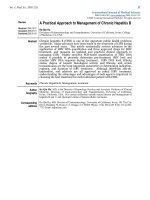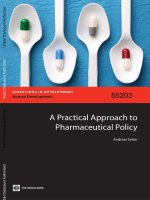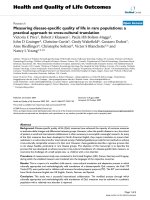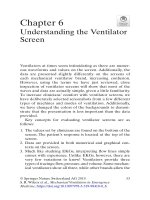Ebook Practical approach to cardiovascular medicine: Part 2
Bạn đang xem bản rút gọn của tài liệu. Xem và tải ngay bản đầy đủ của tài liệu tại đây (7.15 MB, 230 trang )
SECTION V
V
Arrhythmias and
Sudden Cardiac Death
CHAPTER 13
13
Atrial Fibrillation and Flutter
Marco Perez and Amin Al-Ahmad
Department of Internal Medicine, Division of Cardiology, Stanford
University School of Medicine, Stanford, CA, USA
Atrial Fibrillation
• Atrial fibrillation (AF) is characterized by disorganized electrical activity
in the atrium leading to loss of effective atrial contraction (Figures 13.1 and
13.2).
• Most common arrhythmia, affecting 1% of the United States population.
• Associated with an increased risk of stroke (up to 5% per person/year in
the elderly) and death.
Classification
• Paroxysmal: recurrent episodes lasting <7 days
• Persistent: recurrent episodes lasting >7 days, often requiring cardioversion
• Permanent: episodes lasting >1 year
Other terminology used:
• Lone AF:
• No associated hypertension or evidence of cardiopulmonary disease
• Usually applies to younger patients, with a stronger genetic link
• Implies a lower risk of thromboembolism
• Can be paroxysmal, persistent, or permanent
• Acquired AF: not lone AF
• Chronic AF: term formerly used to refer to permanent AF
• Familial AF: AF that runs in families with a Mendelian pattern of
inheritance.
Work-up of New-Onset AF
• Assess for associated conditions: hypertension, heart failure, valvular
disease, chronic obstructive pulmonary disease (COPD), pulmonary
embolism, hypertrophic cardiomyopathy, myocardial infarction (MI),
A Practical Approach to Cardiovascular Medicine, First Edition. Edited by Reza Ardehali,
Marco Perez, Paul Wang.
© 2011 Blackwell Publishing Ltd. Published 2011 by Blackwell Publishing Ltd.
165
166 Arrhythmias and Sudden Cardiac Death
PV
LA
RA
LV
RV
Figure 13.1 Disorganized electrical activity in atrial fibrillation. PV, pulmonary vein
Figure 13.2 Characteristic ECG hallmarks of AF: irregular rhythm and poorly defined P-waves
hyperthyroidism, endocarditis, binge drinking, excessive caffeine, diabetes
mellitus (DM).
• Routine tests to consider:
• Echo:
– Consider in all patients
– High yield for younger patients or undiagnosed cardiopulmonary
disease
• TSH: low yield (<1% of new AF have hyperthyroidism), but routinely
done
• Fasting glucose: if DM not already established.
• Hospitalization: consider if:
• Rate control and hemodynamic stability are not achieved
• MI is suspected (ST abnormalities, chest pain)
• Evidence of heart failure.
• Acute cardioversion: consider if:
• Hemodynamically unstable
• Heart failure believed to be secondary to or worsened by AF
• Signs of end-organ damage: chest pain, altered mental status, renal failure.
Atrial Fibrillation and Flutter 167
Rate and Rhythm Control
In older, asymptomatic patients, who account for the vast majority of patients
with AF, rate control is the first-line therapy.
Consider rhythm control if:
• Patient is symptomatic
• Adequate rate control cannot be achieved or drop in ejection fraction (EF)
is attributed to tachycardia
• Patient is young or has their first episode of AF.
EV I DE NC E - B AS E D P R AC T I C E
Atrial Fibrillation Follow-up Investigation of Rhythm Management (AFFIRM)
Context: Debate as to whether or not aggressive rhythm control is warranted in
asymptomatic patients.
Goal: To compare outcomes in patients randomized to rate versus rhythm
control.
Methods: Multicenter, RCT. 4060 patients >65 years old or risk factors;
symptomatic patients excluded.
Results: No significant difference in mortality or stroke between groups.
Take-home message: Recommend rate control if patient is truly asymptomatic.
Controlling Heart Rate
Target heart rate (HR) is <80 bpm at rest and <110 bpm during normal
activities.
• Beta-blockers:
• Older patients, concomitant cardiovascular disease
• Success is only slightly higher compared with calcium channel blockers
(CCBs) or digoxin
• CCBs:
• Younger, more active patients; side effects from beta-blockers
• Digoxin:
• Good as a second agent when beta-blocker or CCB are insufficient
• Alone is generally not preferred because of the associated toxicities and
need for monitoring.
Achieving Sinus Rhythm
The choice of drugs versus electric shock is guided by patient and physician
preference.
• Drugs:
• Pharmacologic conversion is less efficacious and carries a higher risk of
ventricular arrhythmia
• Does not require sedation
• Ibutilide is most efficacious, closely followed by flecainide and dofetilide
• Amiodarone and propafenone are moderately effective
168 Arrhythmias and Sudden Cardiac Death
• Sotalol is generally not effective
• Class Ic agents are contraindicated in those with structural heart disease.
• Electric shock:
• Sedation is necessary if nonemergent
• Anterior (sternum) and posterior (left scapula) placement of pads is most
effective
• Biphasic: 50 J for <48 h, 100 J for <7 days, 150 J for >7 days. Titrate to max
200 J
• Monophasic: 100 J for <48 h, 150 J for <7 days, 200 J for >7 days. Titrate
to max 360 J
• Biphasic more efficacious. Patients with a permanent pacemaker (PPM)/
implantable cardioverter defibrillator (ICD) should have these devices
interrogated. Higher energy should be considered in obese or large
individuals.
• Anticoagulation:
• Periprocedural stroke rates are as high as 7% in those who are not
anticoagulated
• Therapeutic anticoagulation (INR 2–3) must be documented for 3 weeks
prior to cardioversion, otherwise transesophageal echocardiography
(TEE) should be performed
• Continue anticoagulation for 4 weeks.
Maintaining Sinus Rhythm
• Goal is to select an effective agent with minimal risk and toxicity (Figures
13.3 and 13.4).
• Amiodarone has the lowest risk of ventricular arrhythmia, but has several
associated toxicities and is reserved for those with structural heart disease.
No heart disease
Heart disease
Flecainide
propafenone
sotalol
Heart failure
CAD
Amiodarone
dofetilide
Amiodarone
dofetilide
Sotalol
Amiodarone
dofetilide
Hypertension
LVH
(IVS ≥ 1.4)
No LVH
Flecainide
Amiodarone propafenone
sotalol
Figure 13.3 Algorithm for pharmacologic maintenance of sinus rhythm. CAD, coronary artery
disease; LVH, left ventricular hypertrophy; IVS, intraventricular septal thickness
Atrial Fibrillation and Flutter 169
Class Ia quinidine,
procainamide, disopyramide
Class Ic: flecainide,
propafenone
1
ICa
2
Ito
INa
0
IKsIKur,IKr
3
4
Amiodarone: nonselective
4
Class III
sotalol, dofetilide
Figure 13.4 Myocardial cell action potential. Numbers indicate the phase of the action potential.
Arrows pointing towards the center depict a net cellular influx of ions throughout the corresponding ion channels
Box 13.1 Dosing recommendations in AF
• Amiodarone: Goal = 8 g load, regimens vary. Suggest 1 mg/h x 6 h IV, then
0.5 mg/h, or 400 mg PO bid. After loading, most patients can be maintained on
200 mg qd
• Sotalol: Dose calculated based on age, weight, and creatinine
(www.betapaceaf.com)
• Flecainide: Start 50 mg bid, increase by 50 mg bid q4d to 150 mg bid.
Sustained-release formulation is available. Should be given with an AV nodal
blocking agent
• Propafenone: 150 mg q8h, then titrate to max 300 mg q8h. Should be given with
an AV nodal blocking agent
• Dofetilide: Dose depends on creatinine and QTc. Patient must be monitored
during load. The following medications must be discontinued: cimetidine, CCB,
trimethoprim, ketoconazole, hydrochlorothiazide, prochlorperazine, megestrol
Each antiarrhythmic agent carries risk of VT or torsades; monitor QTc closely
• Class Ic agents (flecainide and propafenone) are first-line agents for those
with no structural heart disease.
• Class III agents (sotalol, dofetilide) are effective but carry a higher risk of
torsades, and inpatient loading is recommended.
• Class Ia agents are generally not as effective and generally are not used.
Dosing recommendations are given in Box 13.1.
170 Arrhythmias and Sudden Cardiac Death
Second-Line Management
• AV node ablation + pacemaker:
• For patients in whom rate control is desired but cannot be achieved with
medications alone
• Usually performed in the older, less active population
• No evidence of survival advantage but may be associated with improved
resting symptoms.
• Pill-in-the-pocket:
• Reserved for patients who rarely have paroxysms (once or twice a year)
and prefer not to take daily medication
• Propafenone (450 mg for <70 kg, 600 mg for >70 kg) after successful inpatient conversion and observation has been studied.
• Catheter ablation (Figure 13.5):
• Consider in patients who have symptomatic AF and have failed
antiarrhythmic agents
• Techniques vary, but all involve electrically isolating pulmonary vein
potentials and ablating fractionated electric signals
• Majority of experience is in young patients with paroxysmal AF
where success rates are of the order of 80% and major complications
about 1%
• Ablation in patients with permanent AF is less well studied, but success
is of the order of 50%
PV
LA
RA
LV
RV
Figure 13.5 Pulmonary vein (PV) isolation via a transseptal catheter ablation approach
Atrial Fibrillation and Flutter 171
• Repeat ablations are often necessary
• Need for long-term anticoagulation after successful ablation is still
controversial.
• MAZE procedure:
• Consider in patients who undergo thoracic surgery for other indications,
such as coronary artery bypass graft (CABG) or valvular surgery
• Original MAZE procedure involved elaborate and time-consuming cutting and suturing around critical structures, resulting in success rates >90%
• Modified techniques use ablative therapy thereby saving time, but do
result in a slightly lower success rates.
• Adjuvant therapies:
• AF can be thought of as a manifestation of diseased atrial tissue
• As in ventricular heart failure, several medications such as angiotensinconverting enzyme inhibitors (ACE-Is), angiotensin receptor II blockers
(ARBs), and statins may reduce AF burden; randomized trials designed
to demonstrate this are ongoing.
Stroke Prophylaxis
• Stroke remains the most devastating consequence of AF.
• Risk of thromboembolism rises with age and associated risk factors.
• Patients with lone AF, younger than 60 years of age without any risk
factors, have stroke rates of 1% per year and can be treated with Aspirin
(ASA) alone (Figure 13.6).
• Most other patients should be placed on warfarin with a goal INR of 2–3.
• Plavix + ASA is not as effective as coumadin, but is more effective than ASA
alone.
CHADS2 scores are often used to help determine risk of stroke (Figure 13.6):
• 0: low risk and may be treated with ASA alone
• ≥3 or prior stroke/transient ischemic attack (TIA): high risk and benefit
most from anticoagulation
• 1–2: intermediate risk and choice of anticoagulation is individualized.
Adjusted stroke rate (%/year)
7
6
5
4
3
2
1
0
Criteria
score
Prior stroke/TIA 2
Age > 75 years 1
Hypertension
1
Diabetes
1
Heart failure
1
0
1
2
3
4
5+6
CHADS2 score
Figure 13.6 CHADS2 score for prediction of rate of stroke
172 Arrhythmias and Sudden Cardiac Death
Managing Special Situations
Symptomatic Rapid Ventricular Response (RVR)
Hemodynamically unstable patients should undergo immediate cardioversion. Stable patients may receive intravenous beta-blockers or CCB for quick
and effective rate control.
Suggested regimens:
• Metoprolol:
• 1.25–5 mg IV, titrate initial dose to response, max 15 mg q3–6h.
• Diltiazem:
• 0.25 mg/kg initial bolus; 0.35 mg/kg repeat bolus in 15 min if needed
• Drip 10 mg/h, then titrate to effect with max 15 mg/h.
Start comparable oral agent early and quickly titrate off IV formulation.
Consider cardioversion if rate control is inadequate and symptoms persist.
Postoperative AF
•
•
•
•
•
Highest incidence (up to 40%) after cardiothoracic surgery.
Unstable patients should be cardioverted.
Patients with permanent AF can be managed with rate control.
Stable patients with new AF can be cardioverted (see above).
It is reasonable to continue antiarrhythmic use for 4 weeks after
cardioversion.
• Long-term anticoagulation usually not indicated if sinus rhythm is
maintained.
• Routine prophylaxis with statins, steroids, or antiarrhythmics is under
investigation.
CL I N I CA L P E AR L S
• Holter monitor may help assess adequacy of rate control.
• Adding digoxin to a beta-blocker or CCB can result in better rate control.
• Patients undergoing electrical cardioversion should have an antiarrhythmic started
beforehand.
• Consider MAZE procedure in patients with AF undergoing other cardiac surgeries.
Atrial Flutter
• Atrial flutter (AFL) refers to a macro-re-entrant atrial tachyarrhythmia
(Figure 13.7).
• Risk of AFL increases with age, is often associated with AF, and is almost
always associated with structural heart disease.
Classification
The distinction between typical and atypical AFL has important therapeutic
implications and can often be made on surface ECG analysis.
Atrial Fibrillation and Flutter 173
LA
RA
IVC
LV
TV
RV
Figure 13.7 Circuit depicting counter-clockwise, isthmus-dependent atrial flutter. TV, tricuspid
valve; IVC, inferior vena cava
Figure 13.8 Characteristic ECG hallmarks of Type I (typical) atrial flutter: “saw tooth” flutter (F)waves; no isoelectric interval in II, III, aVF; atrial rate usually 300 bpm; 2:1 or higher AV block (in
this example 4:1)
• Typical (Type I) (Figure 13.8):
• Wave of depolarizing myocardium that travels around the tricuspid
valve and passes through the isthmus, the area between the inferior vena
cava (IVC) and tricuspid valve (see Figure 13.7)
• Common form of AFL involves a counterclockwise circuit around
the tricuspid valve and is usually associated with positive P-waves in
lead V1
• “Reverse” typical AFL is also isthmus-dependent but travels in a clockwise direction around the tricuspid valve
• On electrophysiology testing, the rhythm is characterized by the presence of an excitable gap and its ability to be entrained in the isthmus.
174 Arrhythmias and Sudden Cardiac Death
• Atypical (Type II):
• Defined as an atrial tachycardia resulting in an undulating ECG pattern
that does not fulfill the classic criteria of typical AFL
• Much less common and less-well understood than Type I flutter, though
it is usually associated with atrial scarring, surgical incisions, or ablative
lines, and is commonly seen after AF ablation.
Management
The evaluation and management of AFL is very similar to that of AF with a
few notable exceptions: AFL is uncommon in the structurally normal heart,
is less likely to persist, and ablative cure is much more feasible in typical AFL.
Patients with AFL are at risk for thromboembolic stroke.
Young Patients with AFL
• Should raise suspicion for underlying structural disease such as rheumatic
heart disease, left ventricular dysfunction and congenital heart disease,
particularly atrial septal defects.
• Echocardiograms should be performed.
Rate versus Rhythm Control
• AFL is normally not sustained longer than a few weeks and conservative
management with rate control is a very reasonable initial therapeutic
approach, unless the patient is hemodynamically unstable, highly symptomatic, or has inadequate rate control.
• Since AFL is often associated with structural heart disease, electrical cardioverion is usually preferred over pharmacologic intervention if early reversion to normal sinus rhythm is desired.
• Relatively low energies (50 J) are usually sufficient.
Maintenance of Normal Sinus Rhythm
• Those with recurrent episodes of symptomatic AFL may require more
aggressive means of maintaining normal sinus rhythm.
• Again, the frequent association with structural heart disease make Class III
agents, particularly amiodarone, the drugs of choice.
• Given the ease and low complication rates of AFL ablation, there
should be a low threshold to refer for isthmus ablation when typical AFL
is present.
Ablation
The macro-re-entrant circuit in typical AFL traverses the isthmus between the
IVC and tricuspid annulus. An ablation line between these two structures
effectively interrupts the circuit (Figure 13.9). Success rates as high as 86%
and low complication rates make this an attractive alternative to long-term
antiarrhythmic therapy, even in the elderly population.
Atrial Fibrillation and Flutter 175
LA
RA
IVC
Isthmus
LV
TV
RV
Ablation
catheter
Figure 13.9 Catheter position in a cavotricuspid isthmus ablation. TV, tricuspid valve; IVC, inferior
vena cava
Stroke Prophylaxis
AFL is associated with an augmented risk of thromboembolic events, including strokes. Although the efficacy of anticoagulation has not been as well
studied as in AF, current guidelines recommend an anticoagulant approach
similar to that for AF.
CL I N I C AL P E AR L S
• When treating patients with antiarrhythmic medications, particularly Class Ic and III
agents, concomitant AV nodal blockade is necessary to prevent slowing of AFL
and 1:1 AV conduction.
• Young patients with AFL should be carefully evaluated for structural heart disease.
Recommended Reading
Clinical Trials and Meta-Analyses
Gage BF, Waterman AD, Shannon W, Boechler M, Rich MW, Radford MJ. Validation of clinical classification schemes for predicting stroke: results from the National Registry of Atrial
Fibrillation. JAMA 2001;285:2864–2870.
Wyse DG, Waldo AL, DiMarco JP et al. A comparison of rate control and rhythm control in
patients with atrial fibrillation. N Engl J Med 2002;347:1825–1823.
176 Arrhythmias and Sudden Cardiac Death
Guidelines
ACC/AHA/ESC 2006 guidelines for the management of patients with atrial fibrillation.
J Am Coll Cardiol 2006;48:e149.
Review Articles
Falk RH. Atrial fibrillation. N Engl J Med 2001;344:1067–1078.
Lee KW, Yang Y, Scheinman MM; University of California-San Francisco. Atrial flutter: a
review of its history, mechanisms, clinical features, and current therapy. Curr Probl Cardiol
2005;30(3):121–167.
CHAPTER 14
14
Supraventricular Tachycardia
Marco Perez and Paul Zei
Department of Internal Medicine, Division of Cardiology, Stanford
University School of Medicine, Stanford, CA, USA
• Supraventricular tachycardia (SVT) refers to the group of tachyarrhythmias
whose mechanisms are critically dependent on the atrium or AV node,
above the His–Purkinje system.
• Although atrial fibrillation (AF) and atrial flutter (AFL) meet this definition
of SVT, the term is often reserved for the remaining tachyarrhythmias.
• These arrhythmias are usually paroxysmal, i.e. the attacks are sudden and
often recurrent.
Differential Diagnosis
Once hemodynamically stable, the initial step in managing a patient with SVT
is determining the likely rhythm based on the surface ECG. It is essential to
distinguish a tachyarrhythmia requiring intervention from sinus tachycardia
or premature atrial contractions (PACs).
The key features in determining the rhythm are (Figure 14.1):
• Narrow (QRS <120 ms) versus wide complex
• Regular versus irregular
• P-wave morphology.
The last feature will help narrow the differential further. There are a few
other causes of SVT, such as sinus node re-entry tachycardia and junctional
tachycardia; however, the diagnoses in Figure 14.1 include the vast majority
of SVTs that will be encountered in the adult patient.
ECG Distinction
A better understanding of the physiology and anatomic pathways of these
arrhythmias allows them to be better distinguished on surface ECG. The
fundamental mechanisms that cause SVT are:
A Practical Approach to Cardiovascular Medicine, First Edition. Edited by Reza Ardehali,
Marco Perez, Paul Wang.
© 2011 Blackwell Publishing Ltd. Published 2011 by Blackwell Publishing Ltd.
177
178 Arrhythmias and Sudden Cardiac Death
Tachycardia
Narrow
Regular
1. Sinus tachycardia
2. Atrial flutter
3. AVNRT
4. AVRT
5. AT
Wide
Irregular
10. SVT with aberrancy
11. AVRT (antidromic)
12. VT
6. Atrial fibrillation
7. AFL variable block
8. MAT
9. Frequent PAC
Figure 14.1 Differential diagnosis of SVTs. AVNRT, atrioventricular nodal re-entrant tachycardia;
AVRT, atrioventricular re-entrant tachycardia; AT, atrial tachycardia; AFL, atrial flutter; MAT,
multifocal atrial tachycardia; PAC, premature atrial contraction
• Enhanced automaticity
• Triggered activity
• Re-entrant circuits.
These mechanisms will be discussed under the relevant SVT.
Types of Tachyarrythmia
Sinus Tachycardia
• The normal sinus impulse initiates in the sinoatrial (SA) node, travels down
atrial-specific fibers to the AV node, where, after a slow conductive period,
it then travels down to the bundle of His and Purkinje fibers, and finally
spreads to the ventricle (Figure 14.2).
• Sinus tachycardia on an ECG is defined by a rate >100 with a P-wave
preceding every QRS complex and a QRS complex following every
P-wave, as well as positive P-waves in lead II and biphasic P-waves in
V1 (Figure 14.2).
• Sinus tachycardia at rest can reach rates up to 180 bpm in adults, particularly during critical volume depletion or septic shock.
Supraventricular Tachycardia 179
SA node
AV node
LA
RA
LV
RV
Figure 14.2 Sinus impulse and ECG for sinus tachycardia. SA, sinoatrial; AV, atrioventricular
Atrial Flutter
• Typical (Type I):
• A macro-re-entrant circuit that travels around the tricuspid valve and
passes through the cavotricuspid isthmus, the area between the IVC and
tricuspid valve, an anatomically narrow region critical to maintenance
of the arrhythmia (Figure 14.3; see Chapter 15)
• Characterized by a “saw tooth” pattern, with absence of an isoelectric
interval (flat line) seen in II, III, aVF (Figure 14.3)
• Flutter rate is typically 300 bpm, but can vary, depending on underlying
structural disease or presence of antiarrhythmic medications
• Due to the refractory period of the AV node, there is usually 2:1 AV block,
resulting in a ventricular rate of 150 bpm, though higher degree and
variable blocks are also seen, particularly when AV nodal blocking agents
are used.
• Atypical (Type II):
• Usually due to a circuit that travels around other anatomic barriers, such
as a surgical scar or ablation line, and does not pass through the cavotricuspid isthmus
180 Arrhythmias and Sudden Cardiac Death
LA
RA
IVC
TV
LV
RV
Figure 14.3 Sinus impulse and ECG for atrial flutter. TV, tricuspid valve; IVC, inferior vena cava
• Rate and P-wave morphology on ECG depends on the size and location
of the circuit and can mimic atrial tachycardia.
Atrioventricular Nodal Re-entrant Tachycardia
AVNRT (Figure 14.4) is due to a re-entrant circuit contained predominantly
within the AV nodal and perinodal areas:
• Re-entrant circuit consists of a loop of tissue with a region of slow conduction critical to sustaining reentry.
• Thus, in AVNRT an abnormal “slow pathway” is present in addition to the
normal “fast pathway”.
• An impulse is initially propagated down both pathways simultaneously.
• However, retrograde conduction via the slow pathway usually terminates
as it collides with antegrade (forward) slow conduction (Figure 14.5).
In this setting, a PAC can initiate the re-entrant tachycardia:
• A PAC initially conducts down the slow and fast pathways; however, only
the fast pathway encounters a refractory phase.
• Slow pathway conduction continues until it reaches the fast pathway.
• By the time the impulse begins to conduct in a retrograde direction up the
fast pathway, the refractory period has ended.
• What follows is a self-maintained circulation of the electrical impulse
around both pathways (Figure 14.6).
Supraventricular Tachycardia 181
SA node
AV node
LA
RA
LV
RV
Figure 14.4 Electrical impulse and ECG for AVNRT. SA, sinoatrial; AV, atrioventricular
Figure 14.5 Normal conduction down AV node with dual pathways (left), followed by collision
with retrograde conduction in the slow pathway (right)
182 Arrhythmias and Sudden Cardiac Death
Figure 14.6 Development of re-entrant tachycardia
In typical AVNRT, the atrium and the ventricle are both depolarized at
almost the same time; because of this, typical AVNRT is often called a “short
RP” tachycardia. On the ECG, the ventricular rate is usually 150–180 bpm.
Since the P-wave is much smaller, it is usually buried within the QRS complex
but an inverted P-wave can sometimes be seen immediately after the QRS
complex (Figure 14.4).
Atypical AVNRT, accounting for 20% of cases, involves reverse flow through
such a circuit.
Atrioventricular Re-entrant Tachycardia
AVRT is due to a reentry circuit that passes through the AV node and an
accessory pathway (an abnormal electrical connection between the atrium
and ventricle outside the AV node, which can be present on the left or right
side) (Figures 14.7 and 14.8).
A delta wave results from the early depolarization of the ventricle
during normal sinus propagation through an accessory pathway (Figures 14.7
and 14.9):
• Shape and direction depend on the location of the accessory pathway
• Presence with a short P–R interval, a wide QRS, and either symptoms of
palpitation or a documented arrhythmia, are diagnostic of the Wolff–
Parkinson–White syndrome.
In a mechanism similar to that of AVNRT, a PAC or PVC can trigger reentrant arrhythmia and the ECG appearance depends on the direction of the
circuit:
• When the direction of the macro-re-entrant circuit is antegrade down the
AV node and retrograde up the accessory pathway, the tachycardia that
results is called orthodromic. The His-Purkinje system is activated first,
resulting in a narrow QRS with an inverted P-wave usually seen between
the QRS and T-wave (short RP). (Figure 14.10).
• When the circuit travels antegrade down the accessory pathway and
retrograde up the AV node, it is called antidromic. The ventricle is activated directly, resulting in a wide QRS and an ECG that resembles VT
(Figure 14.11).
Supraventricular Tachycardia 183
Accessory
pathway
SA node
LA
RA
LV
AV node
RV
Figure 14.7 Electrical impulse and ECG for AVRT
Figure 14.8 Accessory pathway
Figure 14.9 Delta wave
184 Arrhythmias and Sudden Cardiac Death
Figure 14.10 Orthodromic AVRT
Figure 14.11 Antidromic AVRT
Atrial Tachycardia
AT refers to a rapid rhythm originating from a single, focal area in the atrium,
outside the sinus node (Figure 14.12). Although the primary mechanism is
believed to be enhanced automaticity, triggered and micro-re-entrant etiologies are also possible. The morphology of the P-wave on ECG depends primarily on the location of the focus. A focus close to the SA node may resemble
a sinus P-wave.
As with AFL, the ratio of ventricular beats to atrial beats depends on the
refractory period of the AV node. The atrial rate is typically 130–250 bpm,
slightly slower than typical AFL (Figure 14.12). Most AT conducts 1:1; however,
patients with very fast atrial rates, on nodal blocking agents or with AV nodal
disease can have higher degrees of block.
Atrial Fibrillation (Figure 14.13)
AF is characterized by disorganized electrical activity in the atrium leading
to loss of effective atrial contraction. Although its mechanism is not entirely
understood, in many patients it is thought to be triggered by pulmonary vein
potentials and maintained by multiple wavelets in diseased, often dilated,
atria.
The hallmarks of the ECG include:
• Irregular ventricular rhythm
• Absence of clearly defined P-waves
• Occasionally, very low amplitude atrial waves are noted; however, these
are often high frequency and highly irregular.
Supraventricular Tachycardia 185
SA node
LA
RA
AV node
LV
RV
Figure 14.12 Electrical impulse and ECG for AT. SA, sinoatrial; AV, atrioventricular
Atrial Flutter with Variable Block
Although most AFL conducts 2:1, patients can have higher degrees of AV
block, particularly when AV nodal blocking agents are used or when AV nodal
disease is present. The degree of block can also vary from one ventricular beat
to the next, resulting in “variable block” and an irregular rhythm.
Multifocal Atrial Tachycardia
MAT results when at least two different foci in the atrium compete with the
SA node for atrial depolarization and conduction down through the AV node
(Figure 14.14). The finding of MAT suggests severe atrial disease and is often
associated with chronic obstructive pulmonary disease (COPD).
By definition, the ECG must reveal a fast, irregular rhythm with at least
three different P-wave morphologies (Figure 14.14). This latter characteristic
also distinguishes this rhythm from frequent PACs coming from a single focus.
Frequent PACs (Figure 14.15)
PACs are often mistaken for an SVT, particularly when they are frequent or
when nonconducted PACs and post-PAC compensatory pauses result in a
186 Arrhythmias and Sudden Cardiac Death
PV
LA
RA
LV
RV
Figure 14.13 Electrical impulse and ECG for AF
highly irregular rhythm. Frequent PACs are also a sign of diseased, often
dilated, atria and can be a prelude to AF or AFL. The PACs can originate from
a single focus or multiple foci and can be mistaken for MAT. However, if the
majority of beats are of sinus origin, then the diagnosis of MAT is avoided.
SVT with Aberrancy
Most SVTs conduct down the AV node and result in a narrow complex ventricular complex. However, if there is an underlying bundle branch block
(BBB) or a bystander accessory pathway, then the ECG will reveal a wide
complex tachycardia. In some patients without BBB; however, a fast rate of
conduction can lead to a preferential prolongation of the refractory period of
a single bundle branch (usually the right bundle) and result in a wide complex
tachycardia. In these cases, the BBB tends to disappear once the rate slows
down. It is often difficult to distinguish SVT with aberrancy from VT (see
Chapter 15).
Antidromic AVRT
Antidromic AVRT results in a regular, wide complex tachycardia often confused with VT (see above).
Supraventricular Tachycardia 187
SA node
LA
RA
AV node
LV
RV
Figure 14.14 Electrical impulse and ECG for MAT
Figure 14.15 Electrical impulse and ECG for frequent PACs
Ventricular Tachycardia (VT)
See Chapter 15 for a detailed discussion of VT and instructions on how to
distinguish VT from SVT with aberrancy.
Management
Unstable Patients
Initial management of a patient with SVT depends on the stability of the
patient. Any signs of hemodynamic compromise or end-organ damage that
are attributed to the SVT are grounds for urgent management of the SVT:
• Hypotension
• Unresponsiveness









